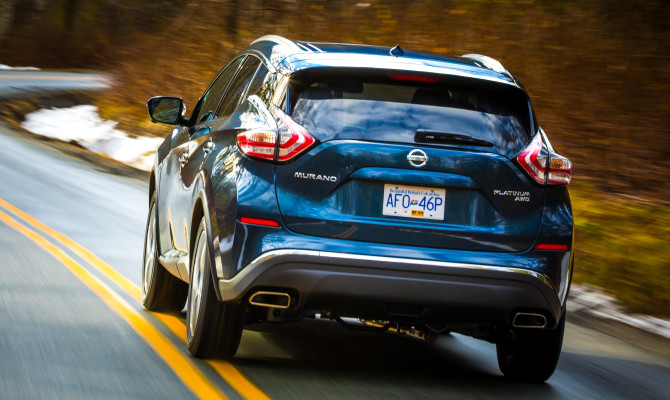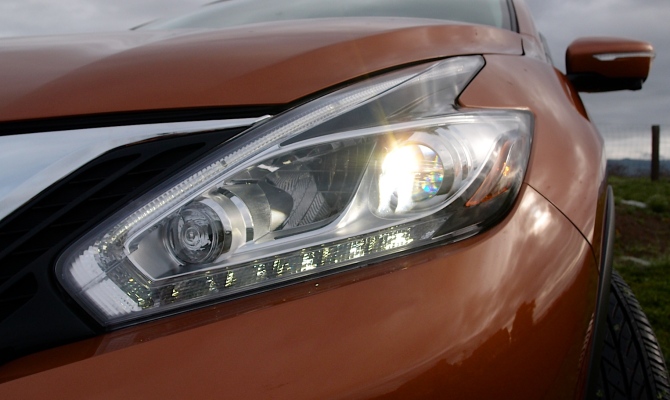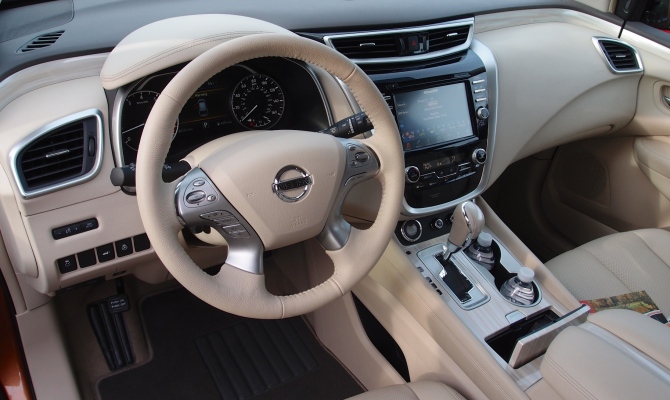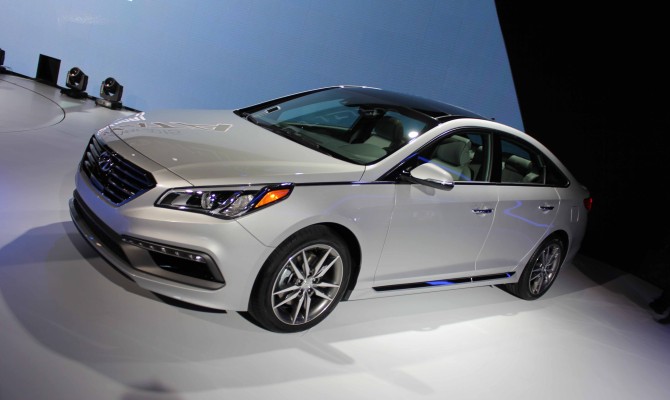“Simply put, this car-based crossover vehicle scores on looks, performance, fuel economy and value for money.”






Nissan led the crossover charge with the introduction of the Murano almost 12 years ago but its imitators soon roared past it on the sales battleground.
First drives of each of this third-generation’s trims clearly indicate that this 2015 version is designed to rectify that state of affairs, even though this segment is far more competitive than it was a decade or so ago. Simply put, this car-based crossover vehicle scores on looks, performance, fuel economy and value for money.
The bulbous-rear of the first iteration of the Murano is long gone. The new vehicle is sleek with a low and sloping roofline. A huge V-shaped grille defines the front. Dare we say, sporty? –
Inside, five passengers will find comfort and room aplenty for human and inanimate cargo. Fold flat seats make add to its versatility.
The external good looks are matched inside but it’s the usability of the controls that make it a real beauty. The touch screen is almost as intuitive as your smart phone of choice.
The Murano S starts at just short of $30,000, which includes Bluetooth with streaming audio, keyless entry, dual-zone climate control and 18-inch wheels. That’s a lot of extras for what passes as standard fare in the in the Murano.
The top-of-the-line AWD Platinum version adds another $15 grand and includes a fabulous oversized sunroof, adaptive cruise control and a predictive forward-collision warning and braking system.
There are less pricey options between the base and top models. For instance, The $40,848 Murano SL AWD offers navigation, a Bose audio system, moonroof, 360-degree parking camera, heated steering wheel, heated leather front seats plus blind spot detection and rear cross traffic alert safety systems.
While the likes of its key rivals, the Ford Edge and Toyota Venza, offer a choice of four- and six-cylinder engines, Nissan is sticking with its trusty 3.5-litre, 260hp, V6 coupled with a continuously variable transmission with a manual shift option. It’s hard to fault the dogged determination to stick with the V6 because it performs well and the continuous tweaking has resulted in improved fuel economy.
If you were to attend any of the major manufacturer media launches, you would hear journo after journo complain about the audacity of carmakers who use CVT. In the old days, CVT deserved its poor reputation with power lags, high revving, uneven gearing and unedifying and unexpected lurches forward! The technology has evolved. And, the fact is the average consumer has no problem with it, liking the smoother transitions.
My first test route was in the Whistler area and showed off its hill climbing skills and the smoothness of the ‘dreaded’ CVT. It’s no gazelle but it is sure-footed and the CVT did not fail even when the driver behaved like a lead foot!
I found the ride to be smooth and highway passing no challenge. Cornering at sensible speeds keeps the vehicle firmly planted. It’s darn quiet too.
Then I spent a week tooling around the city putting it through its shopping paces. Parking on the street was a little challenging but I’ll put that down to impatient drivers behind, not prepared for the Murano’s wide swing needed to get into that tricky spot. On the supermarket lot, it glided into spaces forwards or backwards with ease.
It’s a fine long-distance vehicle but would serve well as a commuter where longer distances are the norm. I can see it being used in the suburbs but it’s a bit large for the centre of the city.
The Murano is not too thirsty for its size – 11.2/8.3 L/100 kms. That’s about two litres per 100 klicks better than its main rivals.
Contact the writer at keith [dot] morgan [at] drivewaybc [dot] ca
**********
Prices:
Murano S FWD, $29,998
Murano SV FWD, $33,698
Murano SV AWD $35,698
Murano SL AWD, $39,098
Murano Platinum AWD, $43,498.
“I believe that this new product has an even larger possible market than just baby boomers…”
When the original Nissan Murano was introduced in 2002, it was one of a number of car-based crossover vehicles that helped build the mid-size family SUV category.
What that original model had was a unique take on design that made it stand out from the crowd. Here we are in 2015 and Nissan wants to recapture some of that original sizzle with this third generation Murano. With a bold, eye-popping design that looks like nothing on the road, this latest model has a sharper price, an upscale interior and refined ride that Nissan believes will appeal to the baby boomers this vehicle is targeted at. After spending a very full day driving around California’s Napa valley, I believe that this new product has an even larger possible market than just baby boomers.
Looks
Since the 2015 Nissan Murano is just about to hit dealership floors, the Napa region was the first in North America to get to see it. By the reaction from other drivers on the road, this mid-sized people mover gets a lot of attention. The bold front design now incorporates the headlamp treatment that will start to migrate across its other vehicles, like the new Maxima coming soon. The wedge shaped look is referred to as a boomerang and it is mimicked in the rear lights as well. Both the front and rear have LED accents and the main headlamps are LED on the top trim levels. The other design highlight is the roof, that looks like it is floating thanks to a blacked out rear windows and roof pillars. This design also features curvaceous rear hips, making the design modern and stylish. Now sold as front wheel drive (FWD) or all-wheel drive (AWD), and priced from $29,998, the Murano is an option for many potential buyers. It is too bad that only the top Platinum model comes with 20-inch wheels, all the other trim levels are fitted with 18-inch wheels.
Inside
The interior is a reason that many people will consider this product, not just affluent baby boomers. The design is simple but looks upmarket; the Murano might be an alternative to buying a Lexus RX350, for less money, or a young family wanting something more upscale than a compact SUV, for not much more money. The dash and surrounding materials all looks first rate. The trim that looks like wood isn’t, rather a plastic that mimics wood but some might think it feels cheap but it certainly looks good. The base $29,998 (FWD) S-Trim isn’t base at all thanks to heated front seats, Bluetooth, navigation, backup camera and satellite radio. The next model up is the $32,998 (FWD) SV and it adds a power driver’s seat, huge moon roof, a power lift gate and heated steering wheel. There is also the $38,398 (AWD) SL that includes leather seats, Bose stereo and more or the top $43,498 (AWD) platinum that amps up the goodies to include heated rear seats, cooled front seats, 20-inch wheels and a host of safety features.
Drive
The 260hp 3.5L V6 engine is a carry over from the last model but the body of the new Murano is 66kg lighter. This and a modified continuously variable transmission (CVT) helps to improve fuel economy to 11.2L/100km in the city and 8.3L/100km on the highway, using the new, stricter fuel ratings for 2015. The tuning of the Murano is very relaxed, almost luxury-like. The steering is very easy to operate; some might find it too light. The pace at which the CVT works is very subdued, meaning the car wants to be in the low RPM range to help extract the best economy but when pushed it can take a while to wake the car up. To get around this there are now set shift points in the CVT that can be accessed through the transmission’s manual mode. It would be better to have a sport setting for the CVT but it isn’t offered.
Verdict
Overall the packaging of the 2015 Murano is very good. The interior has plenty of room for the front and rear passengers and the seats are comfortable. The cargo area is very big and the square shape of the hatch makes loading easier. This product should be attractive to buyers of compact SUVs that want more room and V6 power for just slightly more. Shoppers of premium brands who want a refined ride and interior for less money should consider the higher trim levels. This new Murano will certainly get attention for its exterior styling, but dig deeper there is more to this product than just an attractive look, there is value and comfort that is available to a wide range of potential buyers.
Contact: zack [dot] spencer [at] drivewaybc [dot] ca
The Lowdown
Power: 3.5L V6 with 260hp
Fill-up: 11.2L/8.3L/100km (city/highway)
Sticker price: $29,998-$43,498
Dear Rudolph,
Since you’re the team lead with the reindeer, I want to respond to their request to replace the sled. (more…)
“If you want a mid-sized crossover that will stand out from the crowd, take a look at a 2015 Nissan Murano, and its new price tag!”
Crossovers are the most in demand vehicles in any market you can name…
Mazda CX-3
Freshly unveiled at the Los Angeles Auto Show, the Mazda CX-3 is an all-new compact (crossover) utility.
Like all the latest Mazda products it comes with that distinctive Kodo (Soul of Motion) styling theme and it’s the fifth in a series of the new-generation models to feature the full-package of Mazda’s ground-breaking Skyactiv (fuel-saving) technologies. In dealers next summer (as a 2016 model), the CX-3 is expected to become a new core vehicle in the Mazda line-up.
Power comes from a 2.0-litre gas engine linked to a six-speed automatic transmission and Mazda’s new-generation AWD system. This system employs an active torque control coupling, first used on the Mazda CX-5, plus a new and unique front wheel slip warning detection system. New technologies available include a Mazda Connect infotainment system and its (radar based) i-Activesense active safety system.
The CX-3 has an extra long hood and a flowing shape that raises at the rear to convey a look of strength and power. Large diameter wheels are pushed to the body ends and it has a long 101.2 wheelbase. The chassis employs a lightweight torsion beam rear suspension system.
Forward positioning the front wheels allows the driver extended leg room, on the inside, and space for a hinged (organ-type design) gas pedal. Seating is provided for up to five and the rear seat occupants sit a little taller than those in the front.
Lincoln MKC
Agile, athletic and fuel-efficient are not words you probably associate with Lincoln vehicles, but they can be used to describe the MKC. This all-new and attractive premium compact utility vehicle fits nicely into a revitalized Lincoln line-up that’s more in tune with today’s luxury vehicle buyer. Powered by either a 2.0-litre (10.9L/100km), or optional 2.3-litre (11.2L/100km), turbocharged four-cylinder (EcoBoost) engine, the MKC has a starting MSRP just under $40,000 and comes in three trim levels. All wheel drive is standard plus continuously controlled suspension damping, adaptive electric power-assisted steering and active (cabin) noise control are included in a group of advanced technologies called Lincoln Drive Control.
The MKC’s extra-large rear liftgate is a distinctive wraparound design that includes the full-width LED taillights. Created by using a unique hydro-forming process it gives the MKC a smooth, clean rear appearance and the wider opening provides easier access to its cargo area. A clever optional power feature also allows hands-free operation, to open or close the liftgate, by using a kicking action.
Toyota Highlander
This third generation of Toyota Highlander is sleeker, more fuel-efficient and larger, with three rows of seating, for up to eight occupants. It’s also available in four (3.5-litre) V6 engine editions plus three (V6) hybrid powertrain editions.
The fuel-frugal base LE trim ($31,975) is the only front-drive version. Limited ($45,395) is the top-line all-wheel drive edition and hybrid editions range from $44,015 to $52,990. The 3.5-litre V-6 can generate 270-horsepower and it’s mated to six-speed automatic transmission. Towing is rated at 2,268 kg (5,000 lbs) and a transmission cooler is standard, however, the tow hitch, with a wiring harness, is an option.
While you gain the cool-factor of its utility, as a people-mover it can’t match the practicality of a minivan. Maximum cargo space of 2,370 litres (with second and third rows folded) isn’t close to the Toyota Sienna minivan’s 4,247 litres. Then again, Highlander has real off-road credentials. Good ground clearance, hill-decent and four-wheel-drive locking features keep Highlander in-touch with its roots.
Nissan Murano
If you want a mid-sized crossover that will stand out from the crowd, take a look at a 2015 Nissan Murano, and its new price tag! This third-generation design takes the Murano’s car-like styling to a new level in the utility segment. It’s offered in four trim levels – S ($29,998), SV, SL and Platinum and there’s a choice of front-wheel (S, SV) or all-wheel drive (SV, SL, Platinum).
The start price has been reduced by $4,500 (versus the 2014 Murano S) and prices have dropped on almost all trim levels, even though the new Murano comes with more equipment. Power comes from a 3.5-litre V6 engine connected to an Xtronic (CVT) transmission.
The 2015 Murano has reduced weight (approximately 145 pounds) versus the previous generation, low rolling resistance tires, air grille shutter, low 0.31 Cd, underbody covers that enhance underbody airflow and improvements to the Xtronic transmission.
Honda CR-V
There are many very good reasons why the Honda CR-V is Canada’s best-selling utility vehicle and it gets significant enhancements for the 2015 model year. Honda claims this is the most significant mid-model cycle refresh in its history and the changes include a new direct-injected Earth Dreams Technology i-VTEC engine and a continuously variable transmission (CVT).
Although the current (2014) CR-V provides good fuel economy, the new powertrain combo is even better. When both model years are measured with the new NR CAN’s 5-cycle test method, the combined fuel savings for a front-drive 2015 edition is 1.3 L/100km and the 2015 all-wheel-drive version is 1.1 L/100km more frugal than its predecessor.
In addition to enhanced exterior and interior styling, CR-V also gets a new suite of Honda Sensing safety and driver assistive features, plus some new standard and available features. And there’s more good news, the 2015 Honda CR-V comes with a lower start manufacturer’s suggested retail price (MSRP) of $25,990.
**********
Contact: bob [dot] mchugh [at] drivewaybc [dot] ca
Hyundai would like to put a serious dent in the Toyota Camry success story with its own mid-size sedan – the redesigned Sonata…
NEW YORK, New York.
There was more sizzle in my New York steak dinner than on the show floor at the Big Apple’s international auto show.
It seems the Big Four shot their lightning bolts at the preceding Detroit and Los Angeles auto extravaganzas and left it to the import manufacturers to dazzle here.
Nissan did not disappoint with the unveiling of a classy looking crossover in the shape of the all-wheel drive 2015 Nissan Murano. The mid-size model first showed up in 2002 and this new model marks the birth of the third-generation. The Nissan-named V-Motion nose and boomerang-shaped taillights ensure it makes an impression on the observer, coming and going, and distinguishes itself from its rivals.
Inside, up to five passengers can expect more of a luxury ride than they might have enjoyed in the outgoing version – heated and cooled front seats will impress those upfront. The trend in this segment to include huge sunroofs continues here.
Under the hood, Nissan stays with the trusty 3.5-litre six-cylinder powerplant matched to a continuously variable transmission. Expect to see the Murano in the showrooms at the tail end of the year.
Before moving on, the Nissan Sport Sedan Concept should be mentioned as it offers a clue to what the new Maxima might resemble. And boy, is it a looker despite the horrible orange colour of the show car! It too features a panoramic roof stretching almost from the windshield to the rear window. A production model version is expected later in the year, which suggests the L.A. show might benefit from that timetable.
Any new Toyota Camry is an instant hit, especially in North America where it’s been the best selling car for 12 years. Despite that, the Japanese manufacturer launched an all-new 2015 model, just three years after introducing a redesign.
It incorporates design touches now appearing in sibling models, including a deeper grille that more resembles an upmarket Lexus. Interior materials are upgraded and a large central display matches the design trend of its competitors. Two trims are added; a sporty XSE with some luxury touches and a Hybrid SE. Toyota sticks with its 2.5-litre, four-cylinder, and 3.5-litre, six-cylinder engines plus its Hybrid Synergy Drive.
Hyundai would like to put a serious dent in the Toyota Camry success story with its own mid-size sedan – the redesigned Sonata. It’s likely the introduction of a sharp looking Sonata in 2011 helped prompt Toyota into taking a serious look at upping the ante in the Camry. Other competitors have also risen to the challenge. Now the seventh-generation, newly styled, sharper looking 2015 Sonata raises the bar again with improved ride and handling plus advanced driver assistance and safety equipment.
Unlike the Camry, the Sonata stays with purely four-cylinder engines. Standard is a 2.4-litre power plant and a turbocharged 2.0L four is an option.
The one domestic manufacturer that did show up with something more exciting than the rest was Jeep, which introduced the compact Renegade. It is the iconic brand’s first foray into the small SUV segment.
Its funky looks and fuel efficiency should make it an urban dweller hit but it also boasts best-in-class off-road capability, which may just bring in buyers from the growing outdoor adventure seekers.
Two engine choices: a 2.4-litre Tigershark engine with MultiAir2 paired to the segment’s first nine-speed automatic transmission, or a 1.4-litre MultiAir Turbo engine with six-speed manual transmission.
Prices for all of the above closer to launch when pencils have been sharpened and each figure out how they can undercut competitors!
Recent Comments
- { Enjoyed your Forest of Bowland in the BMW X5M, particularly the photo of the BMW in front of the main part of Stonyhurst College where... }
- { Bantam designed the Jeep, not Willy's or Ford. The American military gave the original Bantam prototype to Willys and Ford to copy. There is plenty... }
- { All Escalades come with a 6.2-lilter V8 engine that produces 420 horsepower. A six-speed automatic is the only transmission offered and drives the rear wheels.... }
- { Alexandra is an excellent journalist. }
Popular Posts
- Journey to a ‘Sparkling’ Luxury Okanagan Resort “Four lucky readers will put a Dodge Journey’s weekend-...
- The Need For Speed: Hike Those Highway Limits More than half of those polled believe the province sho...
- Drives-U-Crazy… Erratic drivers. An early morning drive from Kelowna to Vancouver is nor...
- Readers Respond: The Pros and Cons of Increasing B.C. Speed Limits Increasing the speed limits will only increase risk to...
- Honda CR-V Review: The Compact Crossover To Get Things Done The CRV is a very stylish and aerodynamic crossover veh...




























